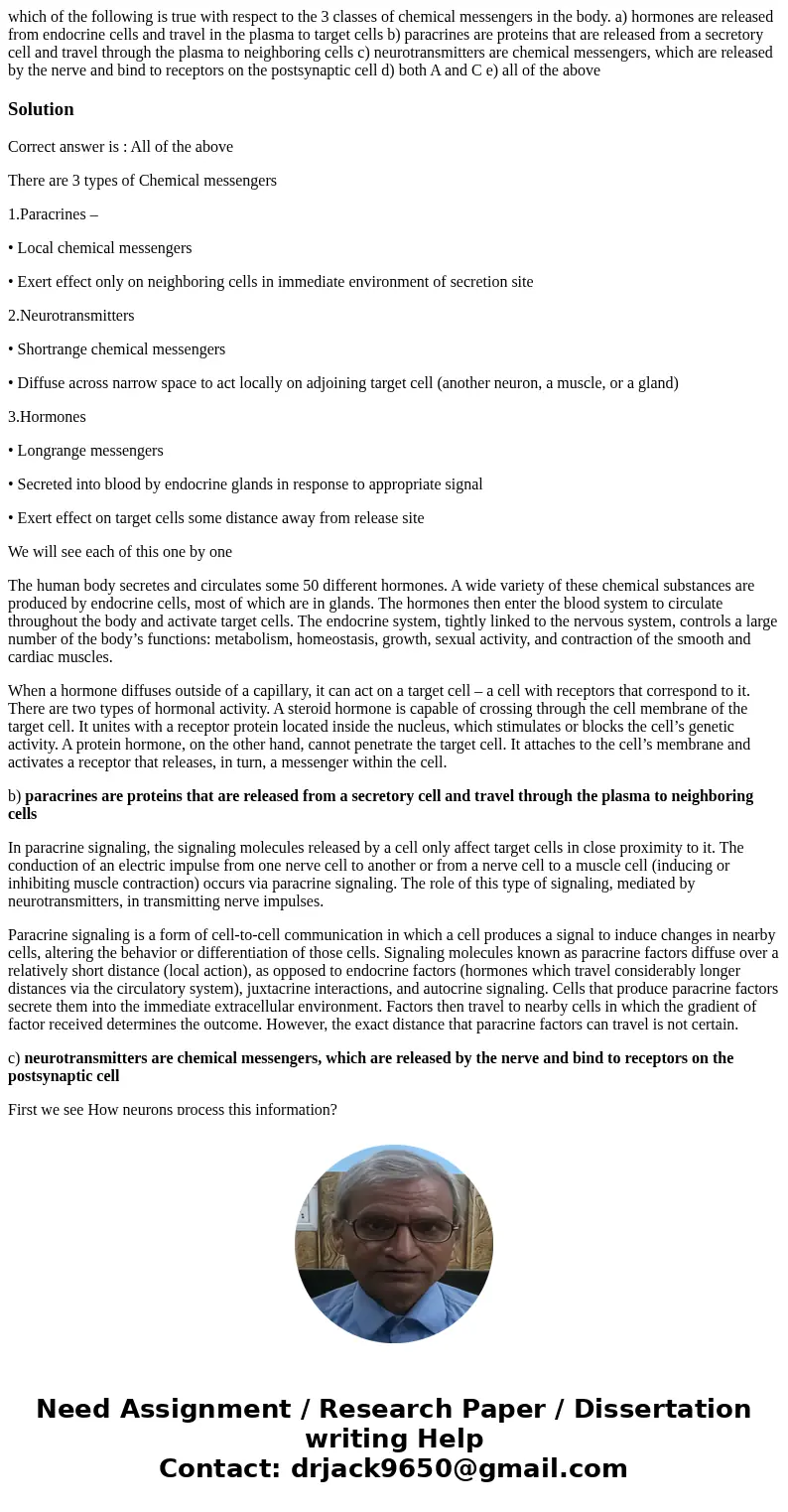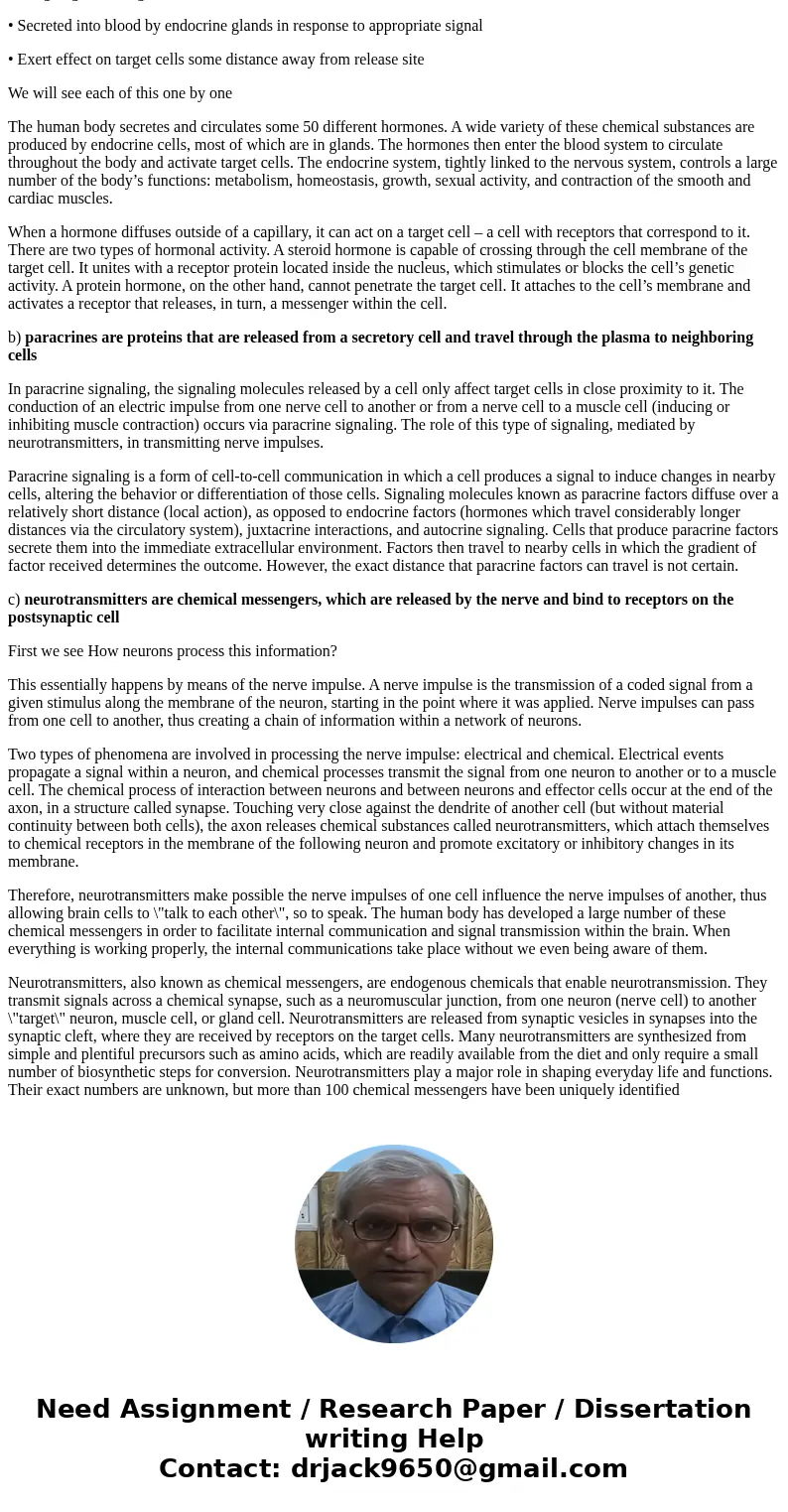which of the following is true with respect to the 3 classes
which of the following is true with respect to the 3 classes of chemical messengers in the body. a) hormones are released from endocrine cells and travel in the plasma to target cells b) paracrines are proteins that are released from a secretory cell and travel through the plasma to neighboring cells c) neurotransmitters are chemical messengers, which are released by the nerve and bind to receptors on the postsynaptic cell d) both A and C e) all of the above
Solution
Correct answer is : All of the above
There are 3 types of Chemical messengers
1.Paracrines –
• Local chemical messengers
• Exert effect only on neighboring cells in immediate environment of secretion site
2.Neurotransmitters
• Shortrange chemical messengers
• Diffuse across narrow space to act locally on adjoining target cell (another neuron, a muscle, or a gland)
3.Hormones
• Longrange messengers
• Secreted into blood by endocrine glands in response to appropriate signal
• Exert effect on target cells some distance away from release site
We will see each of this one by one
The human body secretes and circulates some 50 different hormones. A wide variety of these chemical substances are produced by endocrine cells, most of which are in glands. The hormones then enter the blood system to circulate throughout the body and activate target cells. The endocrine system, tightly linked to the nervous system, controls a large number of the body’s functions: metabolism, homeostasis, growth, sexual activity, and contraction of the smooth and cardiac muscles.
When a hormone diffuses outside of a capillary, it can act on a target cell – a cell with receptors that correspond to it. There are two types of hormonal activity. A steroid hormone is capable of crossing through the cell membrane of the target cell. It unites with a receptor protein located inside the nucleus, which stimulates or blocks the cell’s genetic activity. A protein hormone, on the other hand, cannot penetrate the target cell. It attaches to the cell’s membrane and activates a receptor that releases, in turn, a messenger within the cell.
b) paracrines are proteins that are released from a secretory cell and travel through the plasma to neighboring cells
In paracrine signaling, the signaling molecules released by a cell only affect target cells in close proximity to it. The conduction of an electric impulse from one nerve cell to another or from a nerve cell to a muscle cell (inducing or inhibiting muscle contraction) occurs via paracrine signaling. The role of this type of signaling, mediated by neurotransmitters, in transmitting nerve impulses.
Paracrine signaling is a form of cell-to-cell communication in which a cell produces a signal to induce changes in nearby cells, altering the behavior or differentiation of those cells. Signaling molecules known as paracrine factors diffuse over a relatively short distance (local action), as opposed to endocrine factors (hormones which travel considerably longer distances via the circulatory system), juxtacrine interactions, and autocrine signaling. Cells that produce paracrine factors secrete them into the immediate extracellular environment. Factors then travel to nearby cells in which the gradient of factor received determines the outcome. However, the exact distance that paracrine factors can travel is not certain.
c) neurotransmitters are chemical messengers, which are released by the nerve and bind to receptors on the postsynaptic cell
First we see How neurons process this information?
This essentially happens by means of the nerve impulse. A nerve impulse is the transmission of a coded signal from a given stimulus along the membrane of the neuron, starting in the point where it was applied. Nerve impulses can pass from one cell to another, thus creating a chain of information within a network of neurons.
Two types of phenomena are involved in processing the nerve impulse: electrical and chemical. Electrical events propagate a signal within a neuron, and chemical processes transmit the signal from one neuron to another or to a muscle cell. The chemical process of interaction between neurons and between neurons and effector cells occur at the end of the axon, in a structure called synapse. Touching very close against the dendrite of another cell (but without material continuity between both cells), the axon releases chemical substances called neurotransmitters, which attach themselves to chemical receptors in the membrane of the following neuron and promote excitatory or inhibitory changes in its membrane.
Therefore, neurotransmitters make possible the nerve impulses of one cell influence the nerve impulses of another, thus allowing brain cells to \"talk to each other\", so to speak. The human body has developed a large number of these chemical messengers in order to facilitate internal communication and signal transmission within the brain. When everything is working properly, the internal communications take place without we even being aware of them.
Neurotransmitters, also known as chemical messengers, are endogenous chemicals that enable neurotransmission. They transmit signals across a chemical synapse, such as a neuromuscular junction, from one neuron (nerve cell) to another \"target\" neuron, muscle cell, or gland cell. Neurotransmitters are released from synaptic vesicles in synapses into the synaptic cleft, where they are received by receptors on the target cells. Many neurotransmitters are synthesized from simple and plentiful precursors such as amino acids, which are readily available from the diet and only require a small number of biosynthetic steps for conversion. Neurotransmitters play a major role in shaping everyday life and functions. Their exact numbers are unknown, but more than 100 chemical messengers have been uniquely identified


 Homework Sourse
Homework Sourse